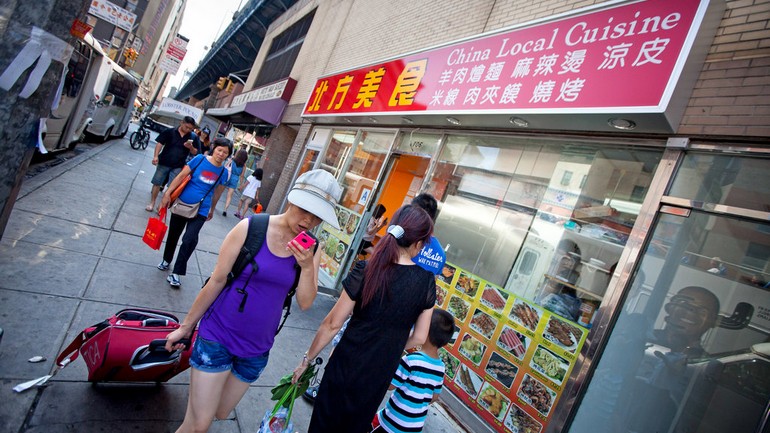
It’s easier to stumble on Taste of Northern China than to find it. The address is 88 East Broadway, but the storefront is around the corner, on Forsyth Street, with a mysterious 106 above the door (a suite number, it turns out). The name Taste of Northern China appears on the menu but not on the sign out front, or at least not in English — the Chinese characters translate roughly as Northern Delicacies, with the not-so-helpful English addendum China Local Cuisine.
偶遇“北方美食”可能还容易些,专门去找反倒不易。它的地址是百老汇东88号,但是店面实际上在街角另一边的福赛斯街,正门上方有个神秘的106号(后来才知道是套房的编号)。菜单上有英文店名Taste of Northern China,门面上只有中文店名,旁边加的英文注释“China Local Cuisine”(中国地方美食)没有太大帮助。
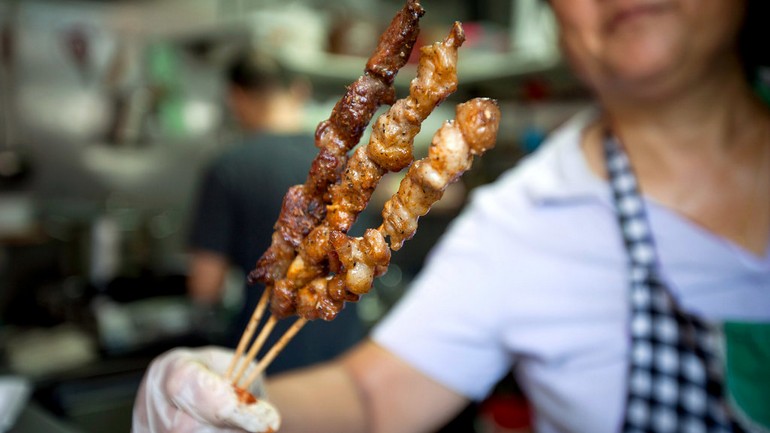
No matter. You’re here now, with a fistful of skewers in loose foil, smoky, salty and heady with cumin and chile: a talonlike whole green pepper, longer than the stick it’s impaled on and crazily hot; string beans cut into two-inch clips and speared horizontally, evoking vertebrae; beautifully tender little chicken hearts, lean and closer to steak than chicken; nubs of translucent beef tendon, to work the jaw; cauliflower freckled with char; a squid’s snaking arm.
不管怎样,反正你已经来了,手里拿着一把烤串,它们用箔纸松散地包着,散发出烟熏味和咸味,上面撒着诱人的孜然和辣椒:整只尖青椒像爪子一样,比竹签还长,特别辣;四季豆切成两英寸长的条,横着串起来,让人想起脊椎;柔嫩的小鸡心含脂肪少,更像牛排,不像鸡肉;透明的牛筋块很有嚼头;花椰菜上布满碳烤的斑点;鱿鱼腿像蛇一样弯曲。
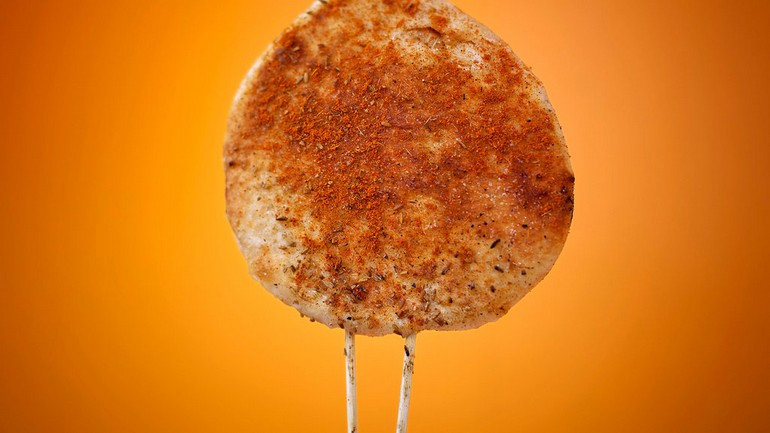
Best is the griddle pancake, as it’s called on the menu, a disc of dense yet somehow still fluffy flatbread that suggests an oversize English muffin, dusted (no, that’s too delicate a word — dredged) in more of that salt-cumin-chile mix and thrust on two skewers to stay upright. It is such a pleasure to carry it, like a lollipop, through the streets of Chinatown, taking small bites of the warm, fragrant bread with the sheerest barbecue crust. Someone could serve these at Smorgasburg with artisanal salts and make a killing.
最好吃的是烤馕,它是一种扁圆面包,筋道而又不失蓬松,有点像大号英式松饼,串在两根竹签上以保持直立,上面洒着(不对,应该说是涂着)更多盐、孜然和辣椒混合物。它就像个棒棒糖,拿着它走在唐人街的大街小巷上,咬一小口这温暖芳香的面包(外层像烧烤的脆皮),很有幸福感。要是有人在Smorgasburg美食跳蚤市场上供应这种烤馕,和艺术盐一起卖,一定会很畅销。
A staple of the Uighur community in northwestern Xinjiang Province, the bread appears elsewhere on the menu stuffed with long-braised, half-collapsed pork with flickers of ginger, garlic, cassia, cloves, coriander and star anise — a Chinese burger, or rou jia mo. It shows up in soup, too, chopped down to the size of mah-jongg tiles and bobbing among translucent mung-bean noodles and thin, pliant strips of lamb.
这种馕是中国西北部新疆的维吾尔人的主食。它还出现在菜单的其他地方,比如肉夹馍,就是把猪肉用姜、蒜、桂皮、丁香、芫荽和大茴香炖得烂熟,用这种饼夹着。这种馕还出现在汤里,被切成麻将块大小,和透明的绿豆粉丝、柔韧的薄羊肉片一起在汤里浮动。
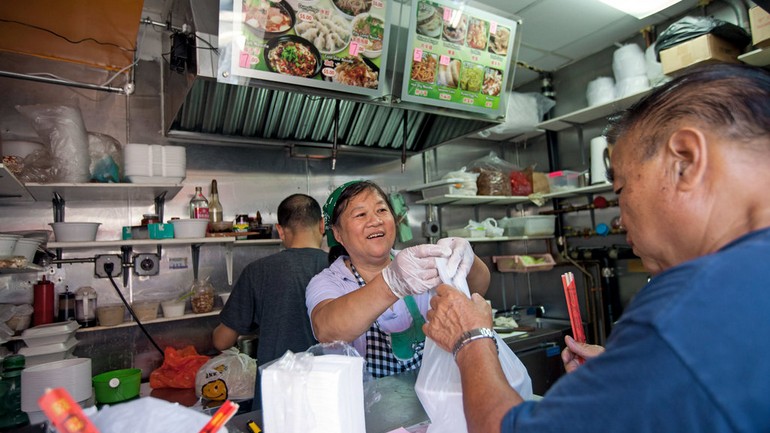
The restaurant’s owner, a robust woman named Hui Jun Wang, is from Henan Province in the east, on the North China Plain. Seamed with rivers and railways, with six other provinces at its borders, Henan has been crossed by strangers from strange lands since Silk Road days. Perhaps accordingly, the menu here draws a wide map.
这家餐馆的主人是个健壮的女人,名叫王慧君,来自华北平原的河南省。该省河流与铁路线纵横交错,与六省接壤,从丝绸之路时起就有南来北往的旅人经过。也许这就是餐馆菜单融合了好几省美食的原因吧。
From Hubei Province, Henan’s southern neighbor, comes re gan mian, or hot-dry noodles: muscular strands, clingy but not sticky, cooked the night before and doused with sesame oil, then cooked again and tumbled with sesame paste, salted chiles and scallions. This is breakfast in Wuhan, Hubei’s capital, and hot only in temperature, more punchy than spicy.
热干面来自河南省南侧的湖北省:面条筋道,有黏性但不粘牙,前一晚煮好,淋上芝麻油,第二天早上再煮一下,加入芝麻酱、咸辣椒和葱花搅拌。它是湖北省省会武汉的早点,这里的“hot”是说面条是热的,并不太辣,很有嚼头。
The former occupant of the shallow, stall-like space was Xi’an Famous Foods, now a thriving restaurant chain. A few Xi’an specialties, from Shaanxi Province to the west, are reprised here, including liang pi, gluten noodles in sesame paste and rousing vinegar, with the balance tilted toward the tang. Rugged hunks of gluten are tossed in, springy touches among crunchy sprouts, peanuts and cucumber.
“北方美食”位于一处路边摊式的狭窄空间,以前属于一家名叫“西安名吃”(Xi’an Famous Foods)的餐馆,如今“西安名吃”已发展成一个兴隆的餐饮连锁公司。西安是河南省西侧的陕西省的省会,那里的几种特色小吃这里也有,比如凉皮,它是一种面筋面条,以芝麻酱和爽口的陈醋调味,两者相得益彰、味道浓郁,并配上粗糙、有弹性的面筋块以及脆脆的豆芽、花生和黄瓜。
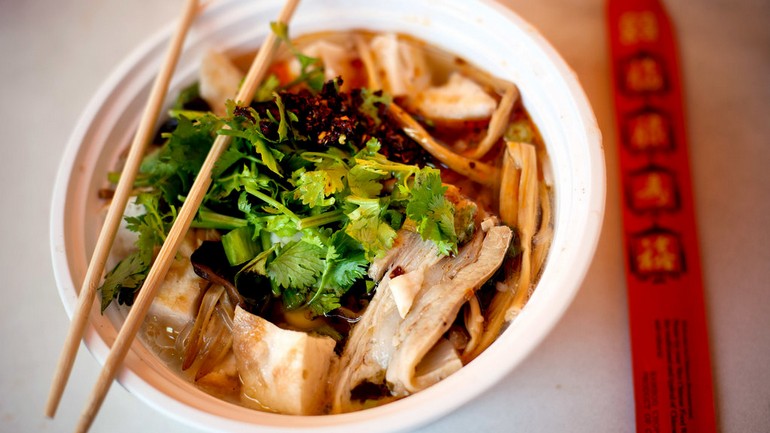
Qishan noodles, also from Shaanxi, are chewy bands in a hot-sour broth, topped by a chile-plowed heap of minced pork, carrot, wood-ear mushrooms and day-lily buds, with the faintest leavening from a crush of fresh parsley. “It looks like an exploded dumpling,” one of my companions said, and then we fell silent, chopsticks warring over it. (Note that this dish appears on the paper menu as “noodles with ingredients” and on the photo menu as simply “pork noodles.”)
岐山臊子面也来自陕西,面条筋道,汤是酸辣味的,里面有辣味碎猪肉、胡萝卜、木耳和黄花菜混合物,新鲜的碎欧芹更为之增添风味。“看起来像是饺子爆炸了,”一个同伴说。说完我们都陷入沉默,开始用筷子跟面条大战。提醒一下,这种面在纸质菜单上写的是noodles with ingredients(带配料的面条),在配照片的菜单上只简单地写着pork noodles(猪肉面条)。
The widest noodles of all lurk in a nearly red broth mobbed by hunks of beef, cabbage and whorls of onion, with the added vehemence of doubanjiang, hot fermented bean paste, in the style of Sichuan Province to the southwest.
最宽的面条隐藏在近乎红色的汤里,被牛肉块、卷心菜和洋葱卷包围,调料是浓烈的豆瓣酱(来自中国西南部的四川省)。
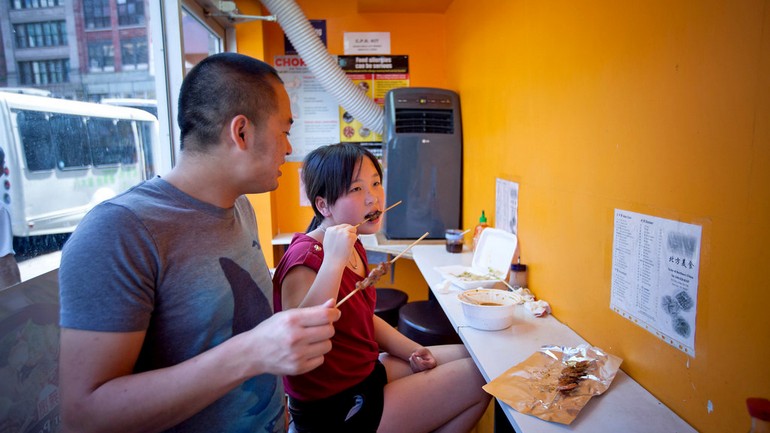
Yes, the tiles are slightly grubby. There are only a few stools along an orange wall. The Manhattan Bridge rattles above. You must pay in cash, but this is easy at $1.25 a skewer, with not a dish over $8.
是的,瓷砖有点脏。只有几张凳子放在一面橘色的墙边。曼哈顿大桥的喧闹在头顶响起。必须用现金支付,但这不是什么问题,因为一个烤串才1.25美元,一餐不会超过8美元。



 闽公网安备 35020302035673号
闽公网安备 35020302035673号
0 responses on "Taste of Northern China In New York"